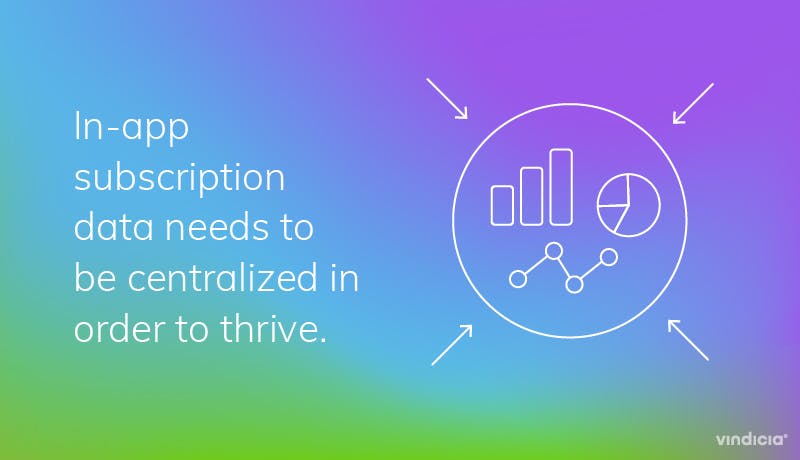Blog
October 28, 2020 | Authored by: Vindicia Team
How subscription companies can stop worrying and embrace in-app subscription purchases
Subscription businesses should be capitalizing on every possible revenue source, including maximizing the value of mobile platforms. Convenient, streamlined in-app purchases (IAP) that comprise downloading an app and completing minimal sign-up steps can be especially advantageous for customers and providers alike, but many subscription services express the need for IAP optimization and guidance.
App Annie’s State of Mobile 2020 Report states that 15% of all revenue from Apple and Google Play app stores are attributed to subscriptions and that subscriptions contributed to 95% of total spend in top non-gaming apps. Leveled with the digital transformation, in-app purchasing is becoming the new norm as more subscriptions adopt a mobile-first outlook. In fact, some subscriptions designate a portion of content and extras made accessible only via mobile. However, subscription providers are facing difficulties with reconciling revenues, accounts, and new signups from all revenue streams. Not having a centralized view of all inputs and outputs creates annoyances for all departments and reaching revenue goals becomes more difficult.
Major IAP challenges facing subscription services
To generate new revenue, subscriptions have numerous obstacles to overcome. Both Apple and Google have strict parameters managing in-app purchases that limit opportunities for monetization, user acquisition, and dynamic pricing. Those same restrictions prevent businesses from having total transparency across their in-app purchase metrics. Lack of transparency poses risks for all components of the subscription lifecycle, hindering optimized monetization and revenue forecasting. Let’s take a closer look at the obstacles and ways to ameliorate them:
- Without a centralized billing management system designed for subscriptions, subscription providers struggle to visualize the impact of in-app purchases on their total revenue, which creates gaps in their customer journey maps.
- Transparency issues also make it difficult for merchants to accurately assess the performance, demand, and pricing of distinct mobile offerings, which runs merchants the risk of continuous support for unpopular products with low ROI.
- Not being able to attribute in-app purchases to specific users, subscription providers lose out on subscriber retention opportunities such as delving into user engagement, tailoring promotions and offerings, cross-selling, and upselling.
- To top off the list, in-app purchases often need to be cataloged manually, further complicating revenue reconciliation requirements by introducing error-prone processes.
These obstacles directly impact a subscription’s end users and their experiences. Not having visibility into which IAP is being purchased poses risks for future product launches. Imagine not having data to guide go-to-market plans. Without end-to-end visibility, the journey stops after the product launch. Google, Apple, and Amazon simply provide platforms to sell; they are not assisting subscription providers with growing subscriptions.
Many of these issues stem from merchants relying on disparate systems to support in-app purchases. Without a centralized system, those companies will not be able to gain complete oversight over the mobile side of their business models.

Solve IAP woes with a centralized subscription billing platform
A centralized billing system can address many of the challenges related to in-app purchases, helping merchants maximize the revenue and value of these transactions. An end-to-end platform provides clear insights into IAP activity, so subscription companies can see its impact on customer acquisition and retention.
By removing transparency barriers and tearing down data silos related to in-app purchases, subscription companies can gain access to several key performance indicators (KPIs). Those metrics offer valuable insights into mobile user behavior and preferences, allowing merchants to effectively engage mobile users and present personalized promotions and offerings. Every engagement tactic will be backed by hard data and KPIs, rather than rely on trial and error. Additionally, monitor objectives and key results together with performance metrics—all made visible to the subscription provider.
A centralized system also ensures that IAP processes and workflows run smoothly without any bottlenecks standing in the way of attempts to better understand customer needs and desires.
Make IAP a pillar of your subscription business model
There are inherent challenges to incorporating in-app purchases into subscription services, but the revenue opportunities are simply too great to ignore. The key to addressing these obstacles is to implement a centralized billing system that provides the transparency and visibility subscription companies need to make the most of IAP revenue streams.
Working with Vindicia, merchants can address their IAP concerns and start maximizing revenue from all transactions. By improving the purchase flow of these transactions, companies can generate more IAP revenue with fewer headaches. Contact our team today to start taking advantage of this incredible opportunity to increase your subscription service’s profitability while meeting your mobile users, on their terms.
About Author

Vindicia Team
We value our subject matter experts and the insights each of them brings to the table. We want to encourage more thought leaders to come together and share their industry knowledge through our blog. Think you have something interesting to contribute as a guest blogger? Contact us at info@vindicia.com